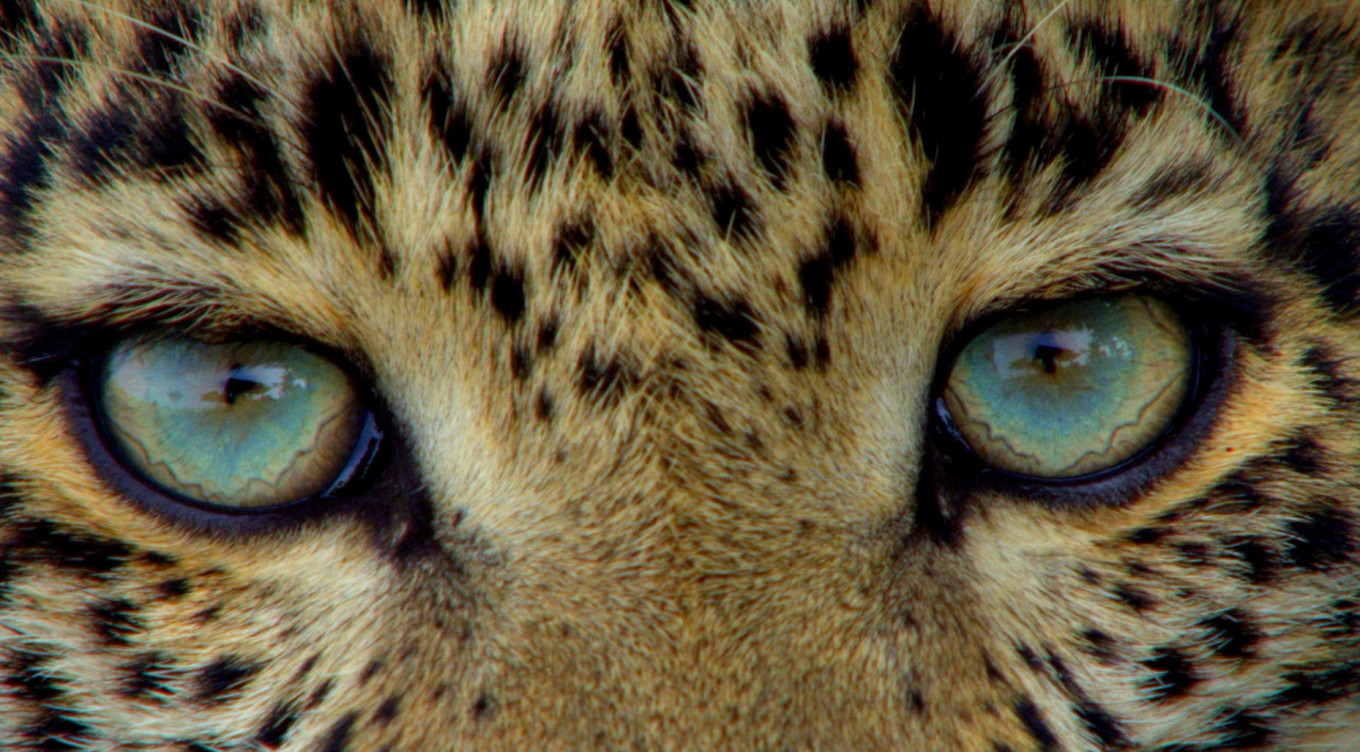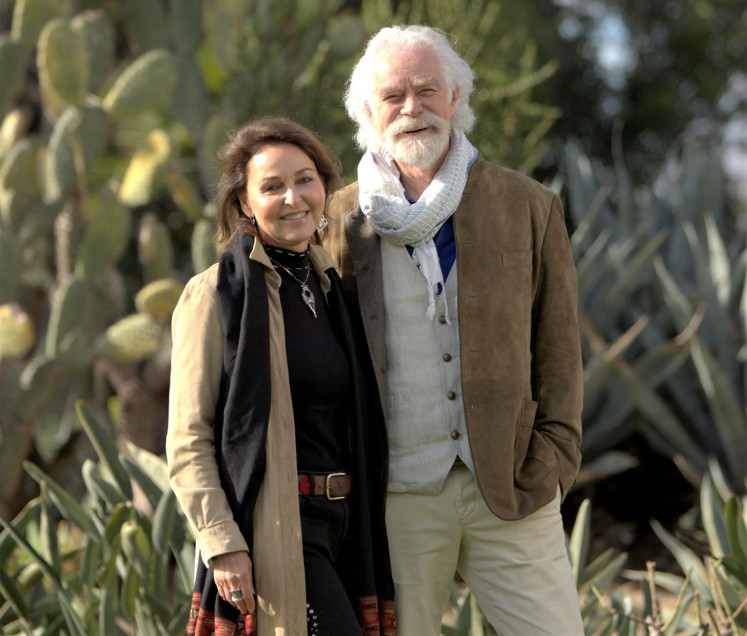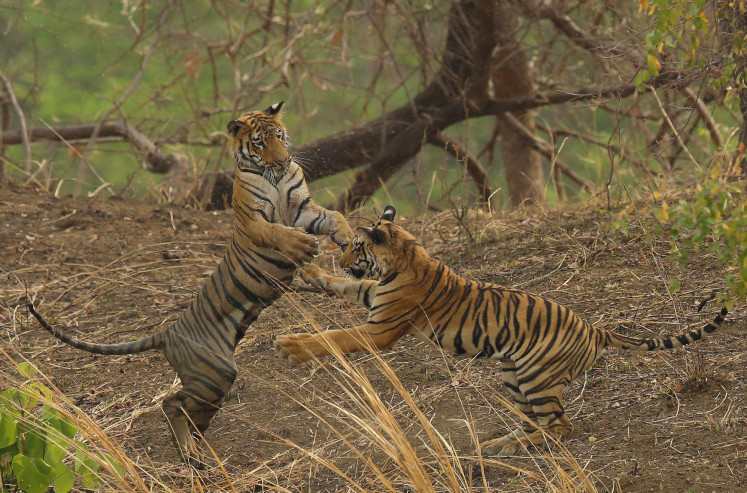Popular Reads
Top Results
Can't find what you're looking for?
View all search resultsPopular Reads
Top Results
Can't find what you're looking for?
View all search resultsFilmmakers blaze trail for big cat conservation
From the struggles motherhood to a curious cub impersonating a bird, National Geographic Wild celebrates the wonders of the feline family.
Change text size
Gift Premium Articles
to Anyone
Toto is a leopard cub with unusual green eyes who observes her world with pure curiosity.
She would climb a tree and occupy a bird’s nest for the whole day just to know how it felt, and she learned a lesson or two about not messing with porcupines – all under the watchful, ember eyes of her mother, Fig.
The coming-of-age film, created by renowned wildlife filmmakers Dereck and Beverly Joubert, is one of seven films about the larger members of the feline family playing now on the Nat Geo Wild channel.
The channel’s annual Big Cat Week, narrated by Oscar-winning actor Jeremy Irons, who voiced Scar in the Lion King, has returned for its 10th edition from Jan. 25 to 31 with a new mission that is more ambitious and urgent than ever.
The program is working hand-in-hand with the Big Cat Initiative, which was founded by the Jouberts and the National Geographic Society in 2009, to halt the decline of the big cats in the wild.
“When we started the Big Cat Initiative and started talking about the decline, nobody believed us. Now, everybody in the world knows that there is a problem with big cats,” said South Africa-based Nat Geo explorer-at-large Dereck in a video interview with The Jakarta Post on Jan. 21.
Globally, leopards now occupy only about 25 percent of their historic range, and six of the nine subspecies of leopards are close to extinction.
Since its establishment, the initiative has completed 150 projects in 27 African countries. They have included on-the-ground research, the removal of life-threatening snares from big cats’ habitats, building livestock enclosures to reduce human-wildlife conflict and providing funds for more than 300 communities to prevent human encroachment on wild cats’ habitats.
For many big cat populations, extinctions are imminent due to habitat loss, degradation and conflicts with humans.
An ongoing project called Project Ranger collects funds for forest rangers who stop poaching, which threatens a number of endangered species and wildlife in general.
The pandemic, according to Beverly, has added more pressure on the communities to earn livelihoods, so they have started to place more snares in the wild.
“[Project Ranger] is truly urgent, just like when we started the Big Cat Initiative. The initiative is providing education on the ground and working with the communities. Project Ranger is looking at the communities keeping the rangers in the field and [determining] how to protect the wild. So the two projects go hand-in-hand.”
Their 2006 documentary Eye of the Leopard started the efforts to raise awareness about big cats, and Jade Eyed Leopard, which premiered on Jan. 25, was a confirmation of the cats’ human-like qualities.
“As you see in the eyes of these creatures, you see their personalities. You realize there’s somebody behind those eyes,” said Dereck, adding that while jade-colored eyes were a rare trait, leopards are their own individuals both physically and in their personality.
“And eyes have become more and more important to us in the past year as everybody now wears masks, so you cannot see their facial expressions. But we’ve all learned to make honest smiles through our eyes, so connecting through eyes has become more important to us.”
Filmed in their habitat in Maasai Mara, Kenya, Jade Eyed Leopard captured the first three years of Toto (the Swahili word for little) with her mother’s nontraditional parenting approach – altruistic, as described by Beverly, who kept her grown daughter by her side by splitting her territory.
Born next to a camp hut in the reserve, Toto and her mother Fig, who recently had two new cubs, were often spotted paying visits to their safe zone.
“We are all surprised by that mimicry of the mother-daughter bond,” said Dereck. “People said the more they see our films the more they realize that the big cats are like us.”
The filmmaking added thermal cameras delivering nighttime wildlife footage.
“It is becoming harder for these animals to survive because we as men are slowly squeezing them in. Deforestation, slashing and burning, the snares, the trade to Asia and, of course, safari hunting are still the issue,” said Beverly.
“We made films hopefully for people to totally fall in love with the creatures and to put their hands up and say, ‘we would love to help you’.”
The dance: A two tiger’s fight in a scene from 'Queen of Taru', which follows iconic Bengal tigress Maya. The film makes use of the Bollywood style of feasting, excitement and drama and revolves around Maya's efforts to secure her bloodline in the kingdom. (Courtesy of National Geographic/-)‘QUEEN OF TARU’
Airing on Jan. 27, Queen of Taru, by Nat Geo explorer-at-large and conservationist Aishwarya Sridhar, follows the iconic Bengal tigress Maya who has ruled a large swath of the Tadoba Andhari tiger reserve in Maharashtra, Central India, for more than five years.
“I first saw Maya when I was very young, so at that point, I didn’t have it in the back of my mind that I wanted to make a film, so I mainly just collected videos of her over time,” she said in a video interview from her home in Mumbai as she turned 24 on Jan. 12.
An incident in which Maya brought her formal mate to kick out an intruding male prompted Aishwarya to tell her story in feature film format.
“And that whole scenario when played out in sequence, I felt that possibly she was closer to humanity than people normally think that cats are. Her strategizing capability is very unique, unlike what has been seen before in big cats.”
[gal:3]
The storyline won a local essay writing competition and the film won Best Film in the Newcomer Category at the Wildlife Conservation Film Festival in 2019.
With the film – which uses a Bollywood style that is entertaining and educational – Aishwarya hopes to change the perception that big cats are ferocious predators incapable of displaying human-like qualities, such as empathy and love.
“I want to portray her as a person who can think, who can love and who is able to redefine her wild genetics,” said the youngest person and first woman to receive the Sanctuary Asia Young Naturalist Award in 2011 and the 2020 Wildlife Photographer of the Year award last October.
Currently finishing a couple of wildlife documentaries, she chose the profession of wildlife photographer and filmmaker to tell stories about the wild and to inspire people to conserve the planet through images and films, especially her generation.
“Although young people account for about 25 percent of the total population, we are 100 percent the future. So it is high time that the youth step up and take the baton and bring out the change that they want to see in the world.” (ste)













